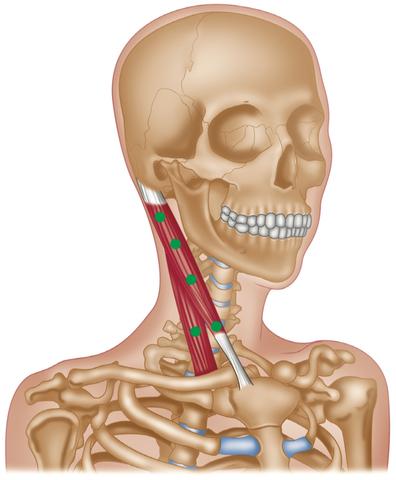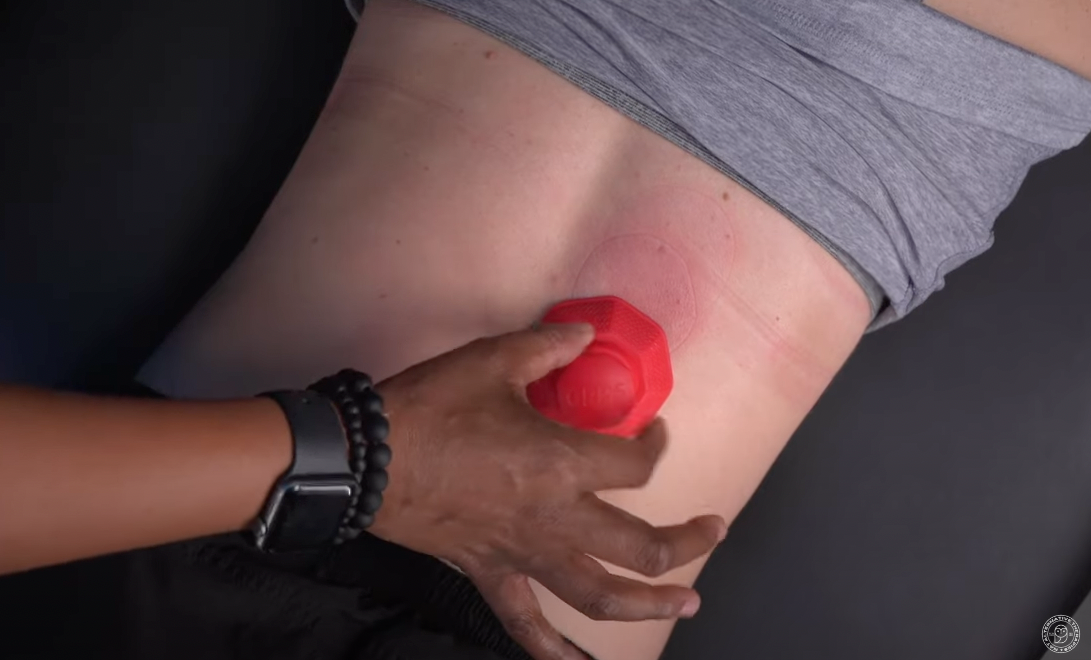Sternocleidomastoid (SCM) Syndrome | Trigger Point Therapy
Stretching the SCM following trigger point treatment
SCM syndrome typically presents as neck stiffness with decreased rotation - sometimes along with nausea, tinnitus, vertigo, or spasms in the neck
The syndrome is most often associated with myofascial trigger points in both the SCM and upper trapezius.

SCM - Common Trigger Point Sites
About the SCM Muscle
The sternocleidomastoid (SCM) muscle is a prominent muscle located in the front of the neck, named for its attachments to the sternum (sterno), clavicle (cleido), and mastoid process of the temporal bone. It consists of two heads, the sternal head originating from the manubrium of the sternum and the clavicular head originating from the medial third of the clavicle. These two heads merge to form a single muscle belly that inserts onto the mastoid process and lateral portion of the superior nuchal line of the occipital bone.
The SCM muscle is primarily responsible for several movements of the head and neck, including rotation to the opposite side and lateral flexion to the same side. Additionally, when acting unilaterally, it assists in flexion of the cervical spine and elevation of the sternum during deep inhalation.
Trigger points in the SCM muscle are common and can arise due to various factors such as poor posture, repetitive strain, or trauma. These trigger points can refer pain to different areas of the head, face, and neck, often mimicking other conditions such as tension headaches or temporomandibular joint dysfunction (TMJ). Common referral patterns include pain behind the ear, around the eye, over the temple, and down into the shoulder.
Trigger point therapy techniques, such as manual pressure or massage, can be effective in releasing tension and alleviating pain associated with trigger points in the SCM muscle. Additionally, stretching and strengthening exercises may help prevent the recurrence of trigger points by promoting better posture and muscle balance.
It's important to note that trigger points in the SCM muscle can sometimes be associated with underlying conditions such as cervical spine dysfunction or brachial plexus irritation. Therefore, it's recommended to consult with a qualified healthcare professional for a thorough assessment and appropriate management plan tailored to individual needs.
Causes
Causes are often posture related with ‘Upper Crossed Pattern’ a common indicator, and it is very much associated with aging.
SCM Syndrome can also be caused by a trauma such as whiplash and is commonly connected with occupation-related repetitive strain - for example, it is known to be prevalent in violinists.
Remember that the head is heavy!
In order to maintain balance the eyes and ears need to be kept level. As people age and experience spinal degeneration, it becomes harder for muscles to prevent the head flexing forward.
We see this a lot in our clinics and the therapist should be aware of the complications associated with treating elderly clients with SCM Syndrome related to spinal degeneration.
In these cases, the elderly client will present with less muscle tone and chronically tightened SCM’s.

SCM and Trigger Point formation - ‘Relative’ head weight according to posture
Spatial Awareness and Balance
Travell and Simons wrote extensively regarding their observations on the role of the sternocleidomastoid for spatial awareness and balance.
They observed that over time a tight SCM with trigger points may well lead to headaches, disequilibrium or vertigo, without the neck stiffness typically associated with SCM Syndrome.
This makes sense when we consider the changes in SCM tone and trigger point formation that occur secondary to altered postural dynamics of the head forward/upper crossed pattern (as above).
It's worth mentioning here that treating SCM trigger points seems to produce consistently good results in addressing the type of dizziness and vertigo that many people with fibromyalgia experience.
This blog is intended to be used for information purposes only and is not intended to be used for medical diagnosis or treatment or to substitute for a medical diagnosis and/or treatment rendered or prescribed by a physician or competent healthcare professional. This information is designed as educational material, but should not be taken as a recommendation for treatment of any particular person or patient. Always consult your physician if you think you need treatment or if you feel unwell.

Learn More for Less

Unlimited access to all CE courses for just $19.95/mo







